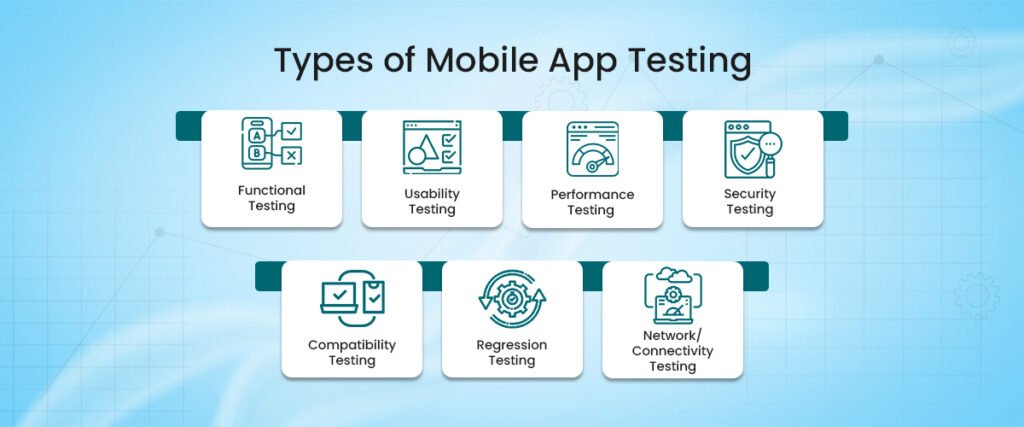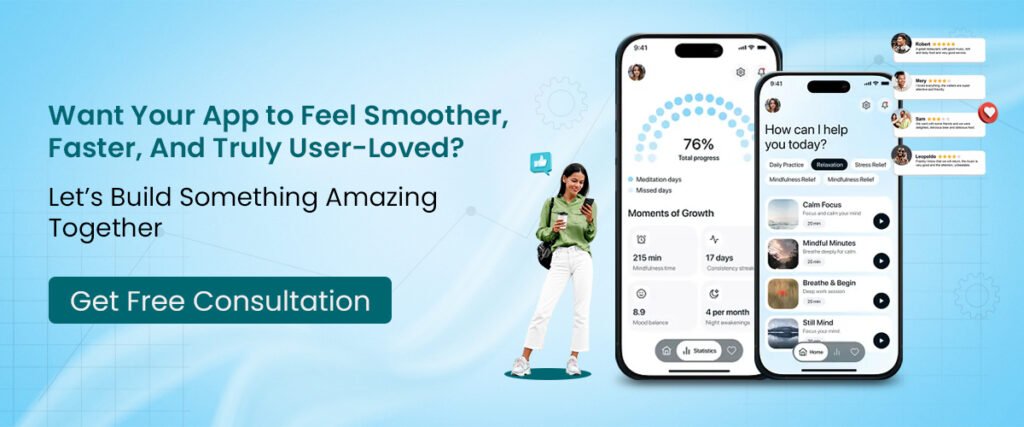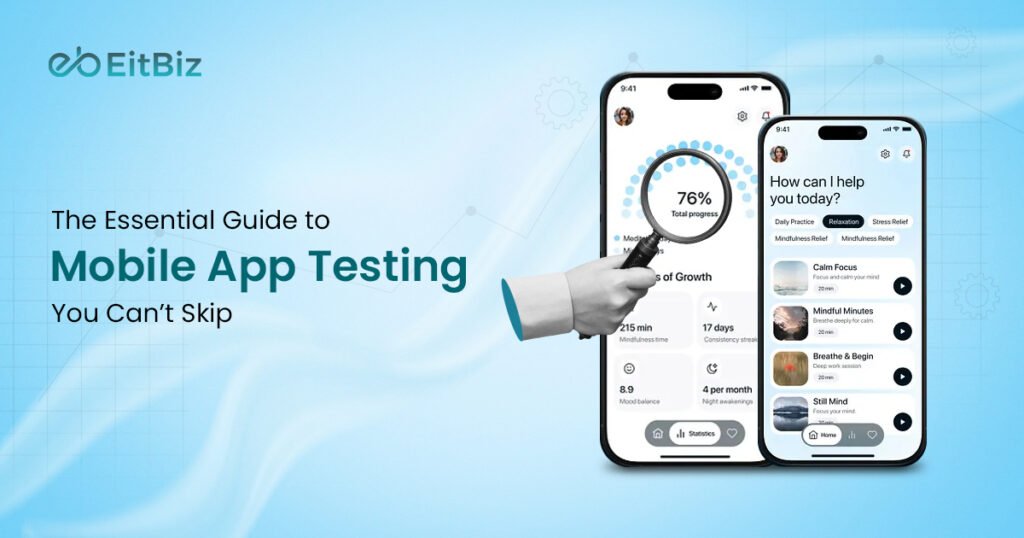Businesses are running after mobile app development in 2026, great!
But have you ever wondered- Why some businesses fail while others succeed?
Well, the answer lies in the mobile app testing!
Although building a dedicated mobile app is an ideal choice for business growth, overlooking mobile app testing may land you in serious trouble.
That’s how important mobile testing is!
Did you know that 90% of users abandon an app because of bugs or performance issues? (Source: Testlio).
Sounds surprising, doesn’t it?
No matter whether you’re a startup or a large-scale enterprise, always conduct mobile app testing before launching an app.
From mitigating potential risks to enhancing user satisfaction, investing in mobile app testing strategies may make your app stand out from the rest.
Let’s discuss what mobile testing is, why testing is important, types of mobile app testing, and how to test a mobile app.
What is Mobile App Testing?
To put it simply, mobile app testing is the process of validating mobile applications across various device platforms and operating systems to identify defects, optimize performance, and deliver a smooth user experience.
Gone are the days when businesses checked mobile apps only to see whether they were working well.
But that’s not the case in 2026!
Now, businesses need to go the extra mile to cover crucial testing areas, including functional, usability, performance, compatibility, and security testing.
When all such aspects are properly considered, the app is likely to deliver a seamless experience while maintaining stability, security, and performance.
Why is Mobile App Testing Important?
Mobile app testing is important because it ensures your app runs well, users enjoy it, it’s free of bugs, and it’s driving the significant revenue you always expected.
Before diving into the reasons, let’s look at some important statistics that show the importance of mobile app testing.
- Nearly 70% of users leave an app if it takes too much time to load.
- Almost 75% of companies reported annual losses of $100,000 due to slow app releases.
- More than 1 in 2 apps is uninstalled within 30 days of download. (Source: CleverTap).
As you can see, overlooking mobile app testing may drain all your effort and hard work. When you’re building a mobile app, mobile app testing plays a significant role.
Let’s discuss the reasons to consider mobile app testing.
#1. Improved UI/UX
App testing allows the quality analyst team to determine the user experience. When you ask your team to check the app, they will first ensure it is intuitive and easy to use. Remember that by testing the app’s logic and goals, you can improve its usability.
{Also Read: Mobile App Design in 2025: Best Practices & Tools to Consider}
#2. Better Performance
When you hire a professional mobile app testing company, their QA engineers conduct app testing across various conditions and devices and platforms, evaluating performance. Furthermore, the app runs smoothly in all scenarios, making it a win-win for every business.
#3. Build User Loyalty
Consistent app testing is crucial to building trust with your users, keeping them satisfied and loyal. As technologies advance rapidly, regular mobile app testing can adapt seamlessly to meet new challenges.
What are the Types of Mobile App Testing?

Here are the types of mobile app testing practices you should know.
1. Functional Testing
It ensures that every feature of the app works exactly as it should. Testers check all actions, buttons, and user flows to confirm the app behaves correctly.
2. Usability Testing
It measures how easy and smooth the app feels for users. Testers observe navigation, clarity, and overall user experience to identify any confusing areas.
3. Performance Testing
The mobile app performance testing evaluates how fast, stable, and efficient the app runs. Testers monitor load time, response speed, battery usage, memory consumption, and behavior under heavy load.
4. Security Testing
It checks how well the app protects user data. Testers look for vulnerabilities, weak authentication, and any risk of unauthorized access or data leaks.
{Also Read: Why Cybersecurity Should Be Your #1 Priority in App Development?}
5. Compatibility Testing
It confirms the app works flawlessly across various devices, screen sizes, OS versions, and hardware configurations. The goal is consistent performance everywhere.
6. Regression Testing
It ensures new updates, bug fixes, or changes do not break existing features. Furthermore, testers re-check earlier functions to maintain stability after every release.
7. Network/Connectivity Testing
It verifies how the app behaves under different network conditions, like 2G, 3G, 4G, 5G, Wi-Fi, low signal, or no connection. The app must stay reliable no matter the network.

What are the Challenges of Mobile App Testing?
Testing mobile applications is far more complex than testing traditional desktop or web software. The diversity of devices, platforms, user behaviors, and network conditions creates unique hurdles that QA teams must overcome. Below are some of the most common challenges faced in the process, as highlighted in any comprehensive mobile app testing guide.
1. Device & OS Fragmentation
With thousands of device models, screen sizes, chipsets, and OS versions in circulation, ensuring consistent performance is difficult. Testers must decide which devices to prioritize while still achieving broad coverage, something every mobile app testing company struggles with.
2. Performance Under Struggles
Mobile users operate in varied environments, including poor network coverage, changing bandwidth, background processes, and battery limitations. Ensuring fast load times and responsiveness requires rigorous mobile app performance testing and even dedicated speed test mobile app checks.
3. Network Variability
Apps may behave differently on 3G, 4G, 5G, or Wi-Fi. Simulating fluctuating network conditions adds complexity to planning and executing tests, making it essential to follow strong app testing best practices.
4. Security & Data Protection
Mobile devices store sensitive personal information, so vulnerabilities can have serious consequences. Robust mobile app security testing is needed to assess risks such as insecure authentication, data leaks, and unsafe third-party integrations.
5. Choosing the Right Tool or Platform
Selecting the correct mobile app testing tools and a scalable mobile app testing platform can be challenging due to the wide range of options. The choice depends on budget, project complexity, device coverage needs, and automation goals.
How to Do Mobile App Testing?
Mobile app testing, as you can see, plays a crucial role in maintaining optimal app performance and user experience. Here’s how to do mobile app testing.
#1. Set Clear Objectives
In the first step, you need to set clear goals for what you really want to achieve from the mobile app testing. Ask yourself- which do you value most: functionality, security, performance, or user experience? Furthermore, you should set clear objectives that help the team stay focused, create meaningful test cases, avoid unnecessary work, and always keep an eye on the real user needs.
# 2. Test on Real Devices and Emulators
Use emulators for quick early-stage checks, but always rely on real devices for final validations. Real devices reveal practical issues related to hardware, battery, sensors, and network variations. When you combine both methods, you get faster development feedback and more accurate, real-world test results.
# 3. Create User-Focused Test Scenarios
Study how actual users navigate the app and turn those behaviors into test scenarios. This approach uncovers hidden usability issues that scripted tests often miss. By following real user journeys, you understand friction points, test natural flows, and ensure the app delivers a smooth, intuitive experience across all major tasks.
# 4. Automate Repetitive Testing Tasks
Use automation for repetitive actions such as login flows, regression tests, and common navigation patterns. Furthermore, automation saves valuable time, cuts down human error, and speeds up release cycles. It also allows testers to focus more on complex, creative, and exploratory testing that requires deeper human judgment.
# 5. Test Under Varying Network Conditions
Simulate various network conditions, including low signal strength, network switching, weak internet, and offline modes. Many mobile issues appear only when connectivity drops or fluctuates. Testing under these conditions helps you verify data handling, loading behavior, and user experience, ensuring your app remains reliable even in unstable environments.
What are the Best Mobile App Testing Practices?
1. Test on Real Devices & Emulators
Use a mix of real devices for accuracy and emulators for speed. Real devices reveal issues related to hardware performance, sensors, and battery usage, while emulators help with quick functional checks during early development.
2. Cover Multiple Platforms and OS Versions
Because users run apps on diverse devices, screen sizes, and OS levels, test across a representative set. Prioritize devices based on market share and your target audience.
3. Validate Under Real Network Conditions
Test the app on 3G, 4G, 5G, and Wi-Fi, as well as in low-network or fluctuating bandwidth scenarios. This ensures the app behaves reliably in real-world environments.
4. Focus on Performance and Load
Evaluate startup time, memory usage, battery impact, CPU load, and responsiveness. Poor performance leads to high uninstall rates, so performance testing should be integrated into every release cycle.
Final Thoughts
So, there you have it! That’s a wrap on the essential guide to mobile app testing in 2026! It is no secret that successful mobile app testing goes far beyond checking features; it requires a strategic approach that blends real-device accuracy, user-focused scenarios, thoughtful automation, and robust network testing. When these elements work together, teams uncover deeper issues, strengthen performance, and deliver apps that feel polished, dependable, and truly user-friendly.
However, mobile app testing requires professional expertise to ensure your business app is thoroughly tested. This is where EitBiz comes in!
EitBiz is a leading mobile app development company with proven expertise in testing mobile apps across diverse industry verticals, leaving no stone unturned. We bring the technical depth, testing experience, and quality-driven mindset needed to elevate your app from “functional” to “flawless.” With a dedicated QA team, real-device labs, and proven testing frameworks, EitBiz ensures every release is stable, secure, and ready for the real world.
Do you want your mobile app to perform at its best, scale confidently, and impress users? If so, let EitBiz build and test your app for smooth, error-free, and conversion-driven performance.
FAQs
1. Which tools are best for mobile app testing?
Tools like Appium, Espresso, XCUITest, and BrowserStack are popular. The right one depends on what you need, including automation, performance checks, or device coverage.
2. Should I test my mobile app on real devices or emulators?
Use both. Emulators are great for quick checks, but real devices show how your app truly behaves in real-world conditions.
3. How much does mobile app testing cost?
The mobile app testing cost may vary based on app complexity and testing needs. Simple apps may cost a few hundred dollars; larger apps or ongoing QA can run much higher.
4. What’s the difference between manual and automated app testing?
Manual testing relies on human testers exploring the app. Automated testing uses scripts to run repetitive tests quickly. Most teams use a mix of both.
-

Sandy K is the dynamic and visionary Director at EitBiz. With a rich tapestry of experience spanning almost 15 years, Sandy has cultivated a unique, global perspective that he brings to the forefront of EitBiz’s operations.
View all posts
Visit Linkedin




